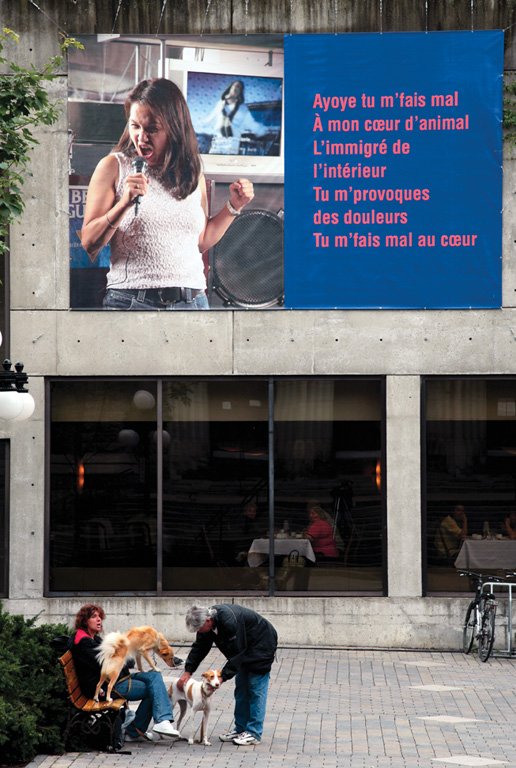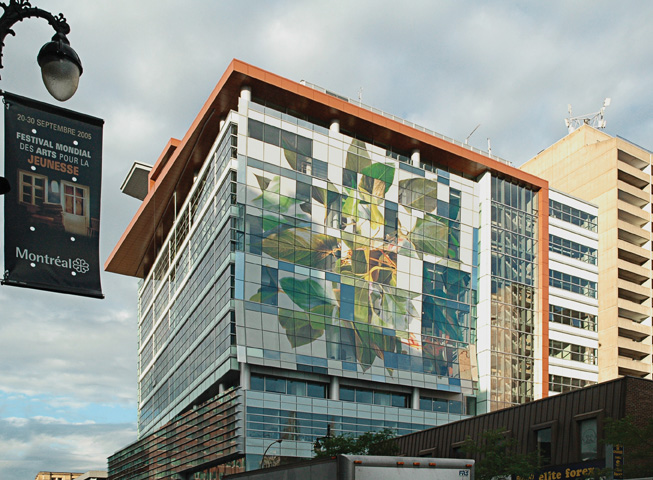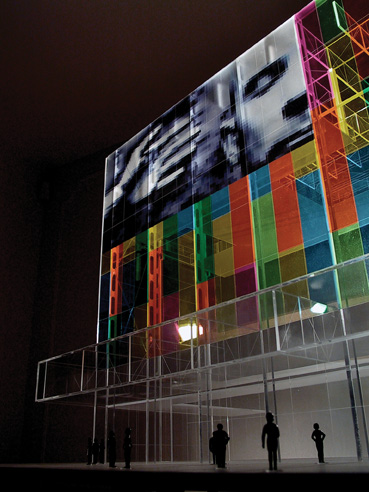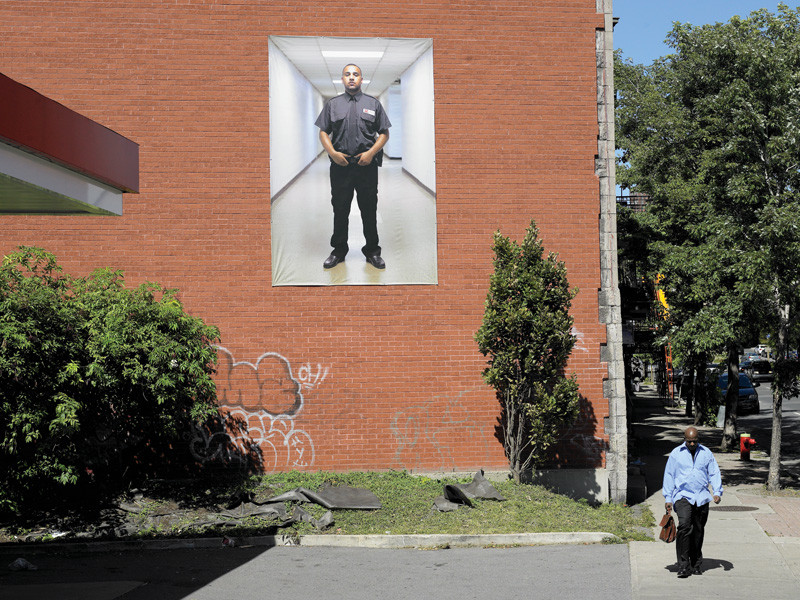[Summer 2009]
The world identifies with the quintessence of photographs. This identification does not occur for no reason. For the world itself is composed of a photographic face. . . . the world has become the photographic present, and the photographic present is fully perpetuated. ⎯ Siegfried Kracauer, 19271
Although photographs are generally flat, they nevertheless occupy a great deal of space, if not all of space: private space, media space, cyberspace, urban space, and so on. In different forms and through various mediations – personal albums, printed materials of all types, cathode-ray screens, billboards – photographs follow us, guide us, and solicit us. Photography is a public medium, possibly the most public, the model and source of all means of mass communication; according to Walter Benjamin, its advent corresponded to a transformation in “human societies’ mode of perception.”2
by Suzanne Paquet
Their mode of appearance so closely ressembles advertising strategies: popping up suddenly, after all, is a favorite tactic of ad people
The city is the privileged site of the photographic invasion. Not only are cities smothered in photographs, but they are often in a “photographic condition,” a state in which an individual may know a place very well without ever having visited it.3 And the city is constantly scanned and gridded by image takers. As far back as the nineteenth century, the pioneers of “street photography,” working with barely adequate equipment, fixed a certain image of cities, a recognizable “face.” Their heirs, from Walker Evans to Robert Walker, took photography itself as a motif for their urban pictures, casting a fascinated gaze on all the images that inhabit the city.
The city is thus always already photographic, in all senses of the term. Does adding a few photographic works, as artistic as they may be, to the spectacle of the city change something about urban life or the image of the city?
Art photography sometimes goes out into the city, is shown on its walls, is inscribed in what is called the public sphere. Two time frames for these urban photographic manifestations may be distinguished, ephemeral displays and permanent placements; defined by the aims linked to production of works, they eventually determine the different terms of reception. To speak of production is to signal the association of creator and developer (or initiator), since these two time frames, the transitory and the lasting, differ with regard to the production apparatus or intentionality that brings them to the public space: permanent works, integration with architecture, are part of a regulated, normalized system, while temporary manifestations allow much more freedom – and eventually more risk – in the modes of display.
Let’s look at a few works to see how the terms of reception differ according to temporal aspects. Translucide, by Michel Lemieux, Victor Pilon, and Jean-François Cantin, on the façade of the Montreal Court House, and Sans titre by Nicolas Baier, at the Engineering, Computer Science, and Visual Arts Building of Concordia University, also in Montreal, are both presented as large glass walls definitively incorporated into their support, the building wall. Access Denied, by Thomas Kneubühler, was composed of a series of large-format photographic portraits displayed on the walls of different buildings in the St-Henri neighbourhood during Mois de la photo à Montréal in 2007. Ken Lum’s Ayoye, a banner attached to a wall facing the St-Roch church in Quebec City, was designed for the event Habiter organized by Centre Vu in 2006. Access Denied and Ayoye were on display in the public space for only a few weeks.
Translucide and Sans titre can be seen from both the interior and the exterior. Observed from the interior, these changing, shimmering works, animated by the viewer’s movement, offer a unique perspective on the city. From the exterior, however – and this is how they are usually seen, since access to the interior is relatively limited – they can be viewed only from a distance. They are thus seen in the general urban scene, as part of a visual profusion that includes other buildings, other images, and a panoply of shapes and colours. In this context, the intended viewer is a generic person, a stroller, an average passer-by. In fact, the standard for programs for integration of art with architecture presumes a form of generality, privileging universalizing, easily intelligible, non-controversial messages. From this distant, general point of view, the works participate in the theatre of the city, but no intimate access is possible. Eventually, these photographic murals, as remarkable as they may be, are so well integrated into the urban spectacle that we forget them, we no longer see them. And this raises a question: if a permanent artwork is not controversial or considered a physical obstacle, is it really visible? In the city as spectacle, so many images clamour for attention that if nothing shocking stands out, the gaze will necessarily be distracted – that is, attracted by something else or simply inattentive. This form of perception, which Benjamin describes as “distracted reception,”4is typical of urban life.
Works on temporary display, provoking impromptu encounters and a certain sense of shock, would probably evade the distracted perception of city dwellers. They are usually addressed to two categories of viewers: people in the neighbourhood (those who should be surprised by sudden appearances) and art lovers who will patrol the area, map in hand, searching for a complete series. For the latter, the process is not so different from a visit to a gallery or museum; they survey streets rather than rooms or corridors, knowing in advance the path that they will take. Access Denied and Ayoye have a direct relationship with the spaces that they occupy – a relationship of a different kind than the one that integrated works have with their environment. Although “users’ representatives” are ordinarily members of panels for programs for integration of art with architecture, we don’t expect these works to appeal directly to the inhabitants of the surroundings. The universalizing messages privileged are, instead, related to the vocation of the institutions in which the works are found.
The photographs that form Kneubühler’s series Access Denied are frontal, larger-than-life pictures of security guards, and they are hung, according to the artist5, in places where the safety of citizens might be threatened, in a neighbourhood generally considered disadvantaged. The inhabitants of the neighbourhood, who, one might presume, are at potential risk, may thus be discomfited, or even outraged, by such a series of images, whose subject, format, and placement might seem provocative. Similarly, Lum’s Ayoye presents, juxtaposed, the words to the eponymous song by Offenbach and a photograph of a young woman of Asian origin who seems to be singing into a microphone. Obviously, the work speaks of alterity. The forecourt of the St-Roch Church is a meeting place for those whom one might call the neighbourhood’s “traditional population,” people for whom the words to the song are very likely to evoke an echo, and who might be surprised that they are associated with an immigrant. But the “immigrant from within” who is the subject of the Offenbach song could be, rather than the young woman in the photograph, these “traditional” residents of the St-Roch neighbourhood, whom gentrification will sooner or later force to migrate. Thus, this work, too, may lead to reflection – or vexation.
Beyond the desire to address the immediate residents of the neighbourhood, such images risk falling into a trap – the one, of course, of too great a resemblance to advertising. The formats of the photographs, and the juxtaposition of text and image in the case of Ayoye, mean that passersby may not distinguish them from the advertising billboards and banners that paper the city, especially because their mode of appearance so closely resembles advertising strategies: popping up suddenly, after all, is a favourite tactic of ad people. The intended viewer is thus confused, which may give the work more depth if the artist uses it deliberately. But doesn’t this proximity between art and commercial posting lead to a distracted reception comparable to that provoked by integrated works? While any permanent work may be subject to this type of reception, without regard to the techniques used, in the case of transitory works it is precisely the photographic medium that brings out this type of perception. Thus, all photographs inscribed or appearing in the public sphere seem to be primarily and irremediably linked to the “photographic face” of the contemporary city. Is this a problem? Not really, if one considers that these images cohabit with urban dwellers and, beyond the vagaries of a certain aesthetic of distraction and the spectacular role that some feel public art should have, they participate, quite simply, in urban life.
Translated by Käthe Roth
1 Siegfried Kracauer, “La photographie” (1927), in L’ornement de la masse (Paris: La découverte, 2008), p. 46 (our translation).2 Walter Benjamin, “L’œuvre d’art à l’ère de sa reproduction mécanique” (1936), in Écrits français (Paris: Gallimard, 1991), p. 182 (our translation).
3 Gus Blaisdell and Lewis Baltz, Park City (Albuquerque, Artspace Press, 1980), p. 229.
4 Benjamin, “L’oeuvre d’art,” p. 217.
5 Isa Tousignant, “Access Denied,” Hour, 6 September 2007. http://www.hour.ca/visualarts/ visualarts.aspx?iIDArticle=12885
Suzanne Paquet conducts research related to the inscription of certain types of art – environmental art, public art, and photography in particular – in the processes of landscape, urban, and spatial production. She recently published Le paysage façonné. Les territoires postindustriels, l’art et l’usage (PUL, 2009). She teaches in the Department of Art History at the Université de Montréal.






